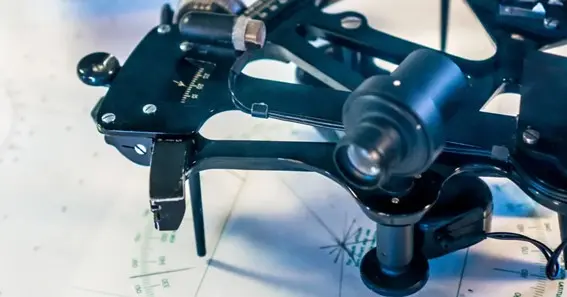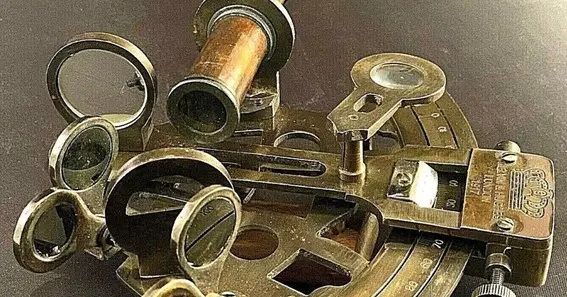What is a sextant? A sextant is necessary for traveling the sky because it shows the angle between two things that can be seen. What it does is measure sky objects’ height above the horizon. This angle reading is essential for finding your exact location at sea or in the air. Here we discuss about what is a sextant and know more about this:
What Is A Sextant?
A sextant is a complicated navigational equipment that measures angular distances with extreme accuracy. A graded circle measures angles from 0 to 120 degrees, usually 60 degrees. The instrument’s main body has a moving index arm and two mirrors: index and horizon.
The horizon mirror’s image of a celestial object must match the horizon line to operate a sextant. Sighting is moving the index arm around until the two images line up.
Sextant Essential Components, Operation, And Modern Relevance

Before using a sextant, you need to know what is a sextant parts and how they work to navigate accurately. Know this:
Components
A sextant is a complex tool for navigating the stars, and it has a few essential parts that work together to make it work. The most important parts of a sextant are:
- Graduated Arc: With a sextant, the arc is the curved, graded scale that usually goes from 0 to 120 degrees. It has exact lines that make it possible to measure angles correctly. The arc is generally made of good metal, so it lasts a long time and is accurate.
- Index Arm: This is an arm that can be moved and is connected to the graded arc. It comes with a micrometer for making small changes. The user can set and measure angles by lining up the index arm with the object being looked at in space.
- Telescope or Sighting Tube: A telescope or sighting tube allows you to see the sky and the stars. It makes things more transparent and magnifies them, essential for accurate sighting. You can change the telescopes or viewing tubes with some sextants to fit your needs.
- Mirrors: The index and horizon mirrors are essential on a sextant. There is also a fixed sky mirror and an index mirror on the index arm. These mirrors are necessary to reflect pictures of the sky and other celestial bodies.
- Micrometer: On the index arm is a small adjustment screw called a micrometer. It lets you precisely change the position of the index arm, which enables you to accurately measure small changes in angle.
Reading The Scale

As we already discuss what is a sextant, now explore using a sextant to measure angles is only possible with the graded arc. To get a correct reading of the scale, you have to figure out what the markings on the arc mean and make small changes with the micrometer screw.
- Scale Measurement: The curve is usually marked with degrees, with smaller steps between each degree. To read the scale, you must find the minute and degree marks where the index arm meets the curve.
- Micrometer Adjustment: The micrometer screw lets you fine-tune the angle measurement for more accurate readings. It helps to make small changes to the index arm for exact angle measurements to the minute.
Maintenance
Keeping a sextant in good shape is essential for its accuracy and longevity:
- Cleaning: Regularly remove dust, dirt, and salt layers from the sextant. Clean the instrument with a soft cloth and the right cleaners to keep the instrument from getting damaged.
- Rust Prevention: Store the sextant somewhere dry and take rust prevention steps to keep it from rusting.
- Calibration: To get exact readings, check and calibrate the sextant often. Checking the instrument’s settings and making necessary changes is part of calibration.
Practical Uses
If you already know what is a sextant, you should know a sextant can do more than help you find your way. It can also measure the distance between things and the height of landmarks, which is helpful for planning and surveying.
Modern Alternatives
Electronic GPS systems have mostly taken the place of sextants in everyday guidance, but they are still helpful:
- Reliability: Sextants are reliable tools that don’t need batteries or electrical systems to work. They are helpful as a backup in case something goes wrong with the technology.
- Educational Value: Sextants are valuable educational tools. They let you learn about celestial navigation and how to measure angles using your hands.
Conclusion
The sextant is essential for navigating the stars because it accurately measures rotational distances. Its ability to determine how high objects in the sky are above the horizon is still very important for correct navigation, whether on the water or in the air.
Navigators can get the most out of this classic tool if they know how to use it correctly and keep it in good shape. In above we discuss about what is a sextant and everything about it.
FAQ
What Do You Do With A Sextant?
A sextant finds the angles at which celestial objects are farthest from the sky. This helps with celestial navigation by figuring out latitude and longitude.
What Does A Sextant Use To Find Angles?
It uses mirrors and a graduated arc to find the angle between a star and the sky. The index arm lines up the pictures for correct reading.
Can You Use A Sextant To Find Your Way On Land?
Yes, a sextant can measure the angles between things on land. This is useful for surveying and planning, but its primary purpose is to help people find their way in the sky and at sea.
How Do You Set Up A Sextant?
Calibration involves adjusting the instrument to obtain accurate results. You can do this by lining it up with known angles or using the tuning tools with the sextant.
Why Is The Sextant Still Functional Even Though We Have So Much Technology?
The sextant is an excellent way to find your way when electronic devices stop working. It also gives you a tried-and-true way that has worked well for hundreds of years.
Sources:
https://en.wikipedia.org/wiki/Sextant








